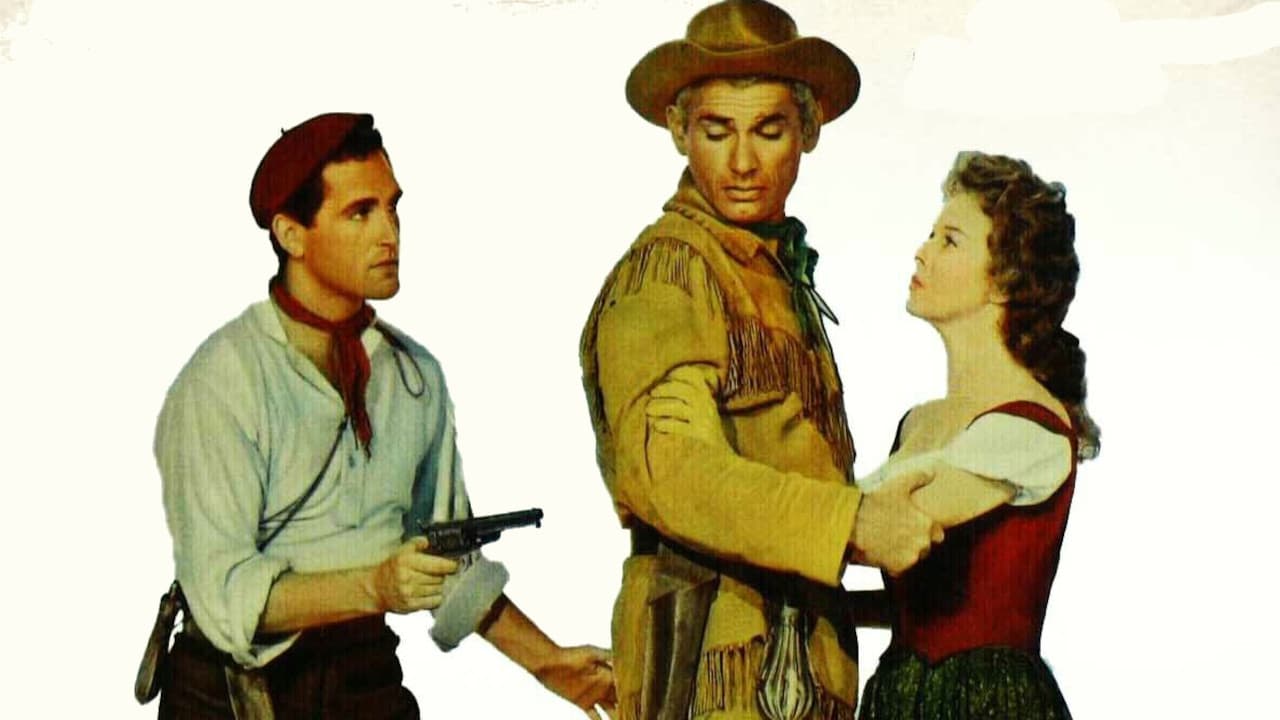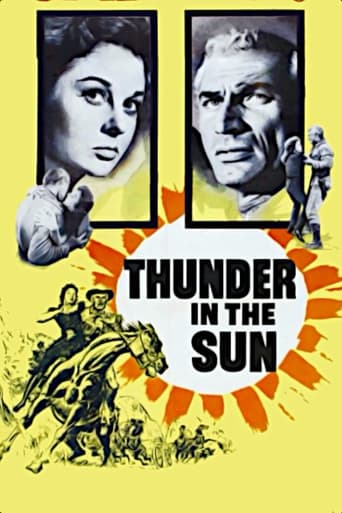

The theme rather reminds me of the HMS Bounty, in which water rations for the crew were minimal, so that fresh water on the ship could mostly be used to keep the breadfruit seedlings alive during the long voyage from Tahiti to Jamaica. In this case, fresh water in the desert portion of the journey is scarce, thus Chandler's wagon master character (Lon) wants the Basques to pitch their cherished grape vines so that the livestock and people have enough to survive. Even though some of the horses die of thirst, the Basques refuse to give up their vines, most vocally by Susan Hayward's character(Gabrielle).Hollywood films of this era usually played loose with historical and geographical accuracy, but this one is especially bizarre. The Basques are from the French side of the Pyrenees, and claim they left their homeland in the wake of post-Napoleonic unrest, one claiming he fought with Napoleon. Lon claims he fought with Washington in the Revolutionary War. Yet, this is supposed to be 1847(or 1850?)!. Historically, it's true that many Basques, especially on the French side, emigrated after the conclusion of the Napoleonic Wars, and that their economy was then in bad shape.Strange that Basques are characterized as introducing grapes(or at least their favorite cultivar) to California. Historically, it was the Spanish missions that established the early plantings in CA, Basques most commonly initially serving as sheepherders in the American West. I was unable to find evidence in support of the supposed Basque customs emphasized in the film of keeping the hearth pot burning perpetually, nor childhood betrothal. Also, the Spanish Flamingo dance near the beginning apparently isn't a Basque trait. The striking ululations made by the men on several occasions apparently are a Basque feature, but are not used for long distance communication nor for war whoops, as featured. Jacques Bergerac, who played Pepe, the brother of Gabrielle's husband, grew up in then Pyrenees region, although I don't know if he was a Basque. The screenplay includes some common features of wagon train films. Of course, there's a confrontation with Native Americans, rather late, not far from their destination. It was staged in the unique Alabama Hills, near Lone Pine and Mt. Whitney, were many a western was partially shot. In fact, most of the film was shot in various locations around Lone Pine, including the Olancha sand dunes,to the south. The prairie fire segment is rather reminiscent of that in "The Texans", filmed 2 decades earlier, except that they had to fight the fire and the Native Americans simultaneously in that one.Like "Westward the Women", when the wagons encounter a stretch of sand it must cross, the wagon master orders all heavy, not absolutely essential, items to be tossed. Historically, this most commonly occurred just before crossing the Rockies, with the fear that the pulling team would otherwise be reduced to a slow crawl up steep slopes. Also, as in "Westward the Women", and, no doubt, some other wagon train sagas, the footloose wagon master is tamed by a beautiful and forceful young woman(Gabrielle in this case) in the train. Presumably, she believes that this hard drinking. womanizing, loner can be made to be satisfied with a sedentary life. But, we Never find out if this works out. However, unlike Taylor's character in the former film, it's Lon who is doing the pursuing of very reluctant Gabrielle, who is married, and then promised by tradition to the brother of her deceased husband(Pepe), when her husband is accidentally shot. Although Lon and Pepe are then enemies during the latter part of the journey, Pepe finally give into Lon when they reach their 'promised land', with the excuse that old customs can be discarded in their new land. Actually, Lon is obnoxiously arrogant when it comes to his self appraisal of his desirability as a lover or husband vs. Gabrielle's husband or Pepe.
... View MoreAt age 12, I saw this picture in a theater when it was first released. It impressed me mainly because of the way the Basque fought -- making huge leaps between boulders, so when I saw it was on TV, I recorded & watched it again. Today, it looks like a very silly story. There are no acting performances or cinematography that redeem this picture. The Basque who have made other reviews on this site needn't be offended -- Hollywood rarely, if ever, depicts American history correctly -- let alone other cultures. The synopsis says this is a western set in the 1850's & that makes sense for Basque immigration (as near as I can tell), but Lon tells the Basque that he fought with Washington (who's last battle was in 1781)while the Basque tell him they fought with Napoleon, which I can date to prox. 1809, maybe earlier. Also, it made no sense to attack the Indians when the wagon train had guns & the Indians only bows & arrows. Women would not have been wearing pants, even riding pants in the mid 1800's. Hayward has many find performances that have stood the test of time & Chandler might have, if he'd lived. This movie is just a curiosity.
... View MoreIf we want Hollywood to get historical and ethnic content correct, then there are precious few movies ever made in Hollywood that are above reproach. Come on! This is just a grade B Hollywood western, and when I saw it back when it came out, I was so entertained and moved by it that I remember it even to this day as a first rate entertainment with unforgettable thrills and spills. Who really cares if the Basques and the native Americans were portrayed accurately? When did Hollywood EVER do that for any group? The reason I looked the movie up here in the first place was because I thought about it for the thousandth time since I saw it and decided it is high time to watch it again. I remembered Susan Hayward (who could forget her?) but couldn't remember who the male lead was. Jeff Chandler, I see now. I just want to say that while I sincerely respect and understand the criticism of the typical Hollywood shallow, thoughtless approach to ethnic and historical accuracy, if you can get past that -- as you MUST do if you're ever going to enjoy these old flicks for what they are worth -- the movie is a whole lot of fun to watch.
... View More....or how History repeats itself.At the end of the 8th century,the Basques beat Charlemagne in Roncevaux in the Pyrénées mountains !When Bergerac evokes his ancestors' feat,he was historically accurate;later the chanson de geste "la chanson de Roland " (which enhanced Charlemagne's so-called nephew count Roland) forgot the Basques and turned them into Sarrazins. ....so the end of the movie is a second "Roncevaux" ,the Indians replacing good old Carolus Magnus and his fair knights.For the rest of the movie,as I do not know anything about the basques traditions,I will not argue with the precedent users who complain about the lack of knowledge of basque culture of the writers.The director used a lot of French actors -Heyward and Chandler are like Martians in such a company- ,all virtually unknown in their native country,even the lead Bergerac.This is a rather short film,mainly if we consider that the beginning consists of singing and dancing (Heyward 's flamenco,more Spanish than Basque,being one of the highlights of a fairly tepid story).Sometimes the Basques speak French,most of the time English,even between them,which makes the story unconvincing.Susan Heyward,as gorgeous as ever,contents herself with a few words .
... View More